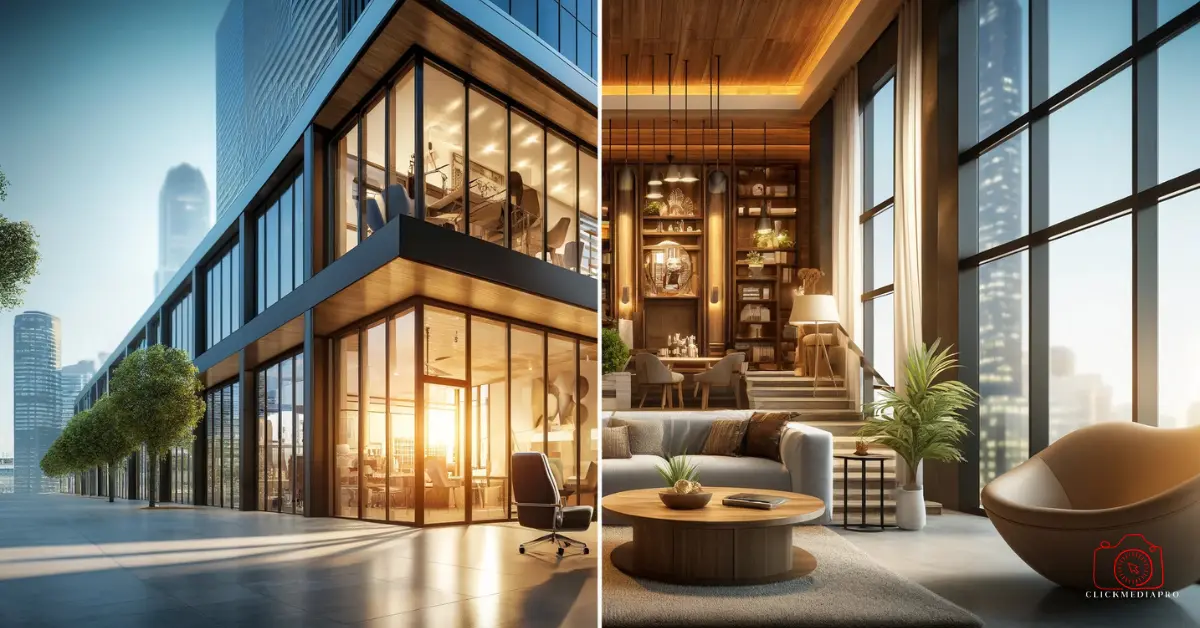Commercial vs Residential Real Estate Photography – In the competitive world of real estate, high-quality photography is a powerful marketing tool. Whether it’s a cozy family home or a towering office complex, professional images can make all the difference in attracting potential buyers or tenants. However, the approach to photographing commercial properties differs significantly from residential real estate photography.
Understanding these differences is crucial for real estate agents, property developers, and photographers looking to effectively market properties in both sectors. This comprehensive guide will explore the distinct techniques, goals, and strategies that differentiate commercial real estate photography from residential photography.
Table of Contents
ToggleUnderstanding Residential and Commercial Real Estate Photography
What is Residential Real Estate Photography?
Commercial vs Residential Real Estate Photography – Residential real estate photography focuses on capturing homes intended for individual buyers or renters. This includes single-family homes, condos, townhouses, and apartments. The primary goal is to evoke an emotional response by showcasing the comfort, warmth, and personality of the living space.
Discover the latest preconstruction homes in Markham, Ontario and explore exclusive opportunities to secure your dream home at unbeatable prices.
What is Commercial Real Estate Photography?
Commercial real estate photography, on the other hand, involves photographing properties intended for business use. This category includes office buildings, retail spaces, warehouses, hotels, industrial facilities, and multi-family investment properties. The focus here is on functionality, scale, and features that appeal to investors or business operators.
Key Differences Between Commercial vs Residential Real Estate Photography
1. Target Audience and Marketing Goals
- Residential Photography:
Targets individual buyers and families. The goal is to create an emotional connection, helping viewers imagine themselves living in the space. Emotional storytelling is central, highlighting comfort, design, and lifestyle. - Commercial Photography:
Targets investors, business owners, and corporate clients. The goal is to showcase the property’s potential for business operations, ROI (Return on Investment), and adaptability. The emphasis is on functionality, space utilization, and business advantages.
Stay updated with expert insights and news on preconstruction projects in Ontario by visiting this comprehensive blog.
2. Commercial vs Residential Real Estate Photography – Photography Style and Approach
- Residential Photography:
Focuses on creating inviting and cozy imagery. Photographers use warm lighting, wide-angle shots, and home staging to highlight comfort and aesthetics. Key features like kitchens, bedrooms, and living areas are emphasized. - Commercial Photography:
Takes a more structured and informative approach. The focus is on scale, structural design, layout, and commercial amenities. Images often highlight conference rooms, office layouts, warehouse space, and customer-facing areas. Precision and clarity are prioritized over warmth.
Browse the most recent Markham real estate listings to find your perfect property in this thriving Ontario community.
3. Use of Lighting
- Residential Photography:
Natural lighting is often favored to create a bright and welcoming environment. Soft, warm tones are used to make the space feel comfortable and lived-in. - Commercial Photography:
Relies on even, neutral lighting to accurately depict the property. Artificial lighting may be used to highlight architectural features, while shadows and mood lighting are generally minimized.
Explore market trends and tips for buying or selling property in Markham by visiting the ultimate Markham real estate blog.
4. Composition and Angles
- Residential Photography:
Emphasizes inviting compositions with wide shots that showcase room flow. Angles are chosen to maximize space and highlight design details. - Commercial Photography:
Focuses on symmetry and structure. Photographers often use head-on shots to convey scale and professionalism. Aerial and panoramic shots are common for large complexes or retail locations.
Enhance your property listings with stunning visuals by partnering with real estate photography experts in Markham at Click Media Pro.
5. Editing and Post-Processing
- Residential Photography:
Post-processing may involve soft editing to enhance warmth, brightness, and saturation. Sky replacements, virtual staging, and minor touch-ups are common. - Commercial Photography:
Editing is minimal and aims for accuracy. Adjustments are made to ensure that dimensions, lighting, and colors reflect the true nature of the property. Over-editing is avoided to maintain professionalism.
6. Use of Drone and Aerial Photography
- Residential Photography:
Drones are used selectively for high-end properties to showcase landscapes, swimming pools, or large yards. - Commercial Photography:
Drone photography is often essential to capture the scale of industrial parks, office buildings, or retail centers. Aerial shots are used to highlight parking availability, location visibility, and surrounding infrastructure.
7. Incorporation of Branding and Business Identity
- Residential Photography:
Generally avoids overt branding, focusing on the home’s appeal. - Commercial Photography:
Frequently includes branding elements, such as signage, logo placements, and company colors to demonstrate the space’s business potential.
Techniques for Capturing Commercial Real Estate – Commercial vs Residential Real Estate Photography
1. Focus on Functionality
Highlighting the functional aspects of the property is critical. This includes:
- Open office layouts
- Conference rooms
- Parking facilities
- Storage and warehouse space
- Accessibility features (elevators, loading docks)
2. Highlight Location and Accessibility
Commercial properties thrive on location. A photographer should emphasize:
- Proximity to highways, airports, or public transport
- Visibility from major roads
- Nearby amenities such as restaurants, shopping centers, or hotels
3. Showcase Adaptability and Space Utilization
Businesses want flexible spaces. Capture images that demonstrate:
- Modular workspaces
- Open floor plans
- Possibilities for expansion or customization
4. Include Contextual and Environmental Shots
For commercial properties, context matters. Include:
- Aerial views showing the surrounding business district
- Night shots to showcase lighting and ambiance for retail spaces
- Pedestrian and traffic flow to demonstrate customer access
5. Use of Virtual Tours and 3D Imaging
With technological advancements, 3D virtual tours and interactive floor plans have become essential tools in commercial real estate marketing. These tools help remote investors or corporate buyers explore the space in detail.
Challenges in Commercial Real Estate Photography
1. Size and Scale
Commercial properties are often larger than residential spaces. Capturing their scale requires:
- Drone photography
- Panoramic stitching
- Specialized wide-angle lenses
2. Lighting Control
Many commercial buildings have mixed lighting (fluorescent, LED, natural light). Balancing these light sources can be challenging and requires:
- Color correction during editing
- Use of additional lighting gear
3. Accessibility and Permissions
Commercial spaces may be in use during photography sessions. Coordinating around business hours or securing permissions from tenants can pose logistical challenges.
4. Emphasizing ROI
Commercial buyers are more data-driven. Photography must convey the property’s business potential, efficiency, and financial benefits.
Tips for Effective Residential Photography – Commercial vs Residential Real Estate Photography
- Stage the Home – Use minimal, tasteful décor to highlight the space’s potential.
- Use Natural Light – Shoot during daylight hours to maximize brightness.
- Focus on Key Areas – Kitchens, living rooms, and bedrooms should be the focal points.
- Enhance Curb Appeal – Capture exterior shots with a clean, inviting look.
- Edit for Warmth – Subtle enhancements make the space feel cozier.
Tips for Effective Commercial Photography – Commercial vs Residential Real Estate Photography
- Capture Scale and Layout – Use wide shots to show floor plans and space.
- Highlight Infrastructure – Show parking, elevators, loading docks, and signage.
- Use Aerial Shots – Demonstrate location advantages and property size.
- Maintain Accuracy – Ensure images accurately represent the property.
- Emphasize Business Potential – Showcase how the space can support business growth.
Conclusion – Commercial vs Residential Real Estate Photography
Commercial vs Residential Real Estate Photography – Residential and commercial real estate photography serve distinct purposes and audiences. While residential photography is all about creating emotional connections and showcasing comfort, commercial photography focuses on functionality, scale, and business potential.
Commercial vs Residential Real Estate Photography – Understanding these differences allows photographers and real estate professionals to craft marketing materials that resonate with the intended audience. Whether you’re selling a family home or leasing office space, aligning your photography strategy with your goals can make a significant impact.
Investing in the right photography techniques not only enhances a property’s appeal but also drives faster sales and higher returns. In a market where first impressions are everything, professional real estate photography—tailored to either residential or commercial needs—is an invaluable asset.

